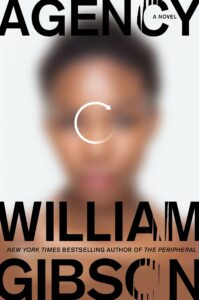Readers who made it through the first few unforgiving chapters of The Peripheral and went on to enjoy the rest of the book will find the beginning of Agency easier going, with the essential setup unchanged and many of the characters returning. In the main timeline sometime late in the twenty-second century, humanity has mostly overcome the interlocking crises that Gibson calls “the jackpot” and is now generally managing the planet without major additional damage. The price has been very high.
The central conceit of The Peripheral, Agency and the third part of the trilogy, which Gibson has said is simply called Jackpot, is that advanced computation has worked out ways to contact alternative pasts to the characters’ present, known in the book as “stubs.” Once contacted, the possibilities from that past branch off and lead to different futures, thus preserving causality at the future end. It’s all a bit handwavy, as it must be, but it works within the book because the limitations feel real, and Gibson keeps the rules consistent once he establishes them.
The Peripheral featured one stub, but implied the existence of many more. Gibson sets Agency in motion by having Detective Inspector Ainsley Lowbeer mention someone who had been a “hobbyist of hellholes.” (Ch. 2) Known as Vespasian, he apparently developed a method for intervening in stubs that led to dramatic changes away from the history known by the main timeline. Lowbeer has had him killed in the meantime, but she thinks she can adapt the method toward radically better outcomes than the main timeline. He had also made contact with a stub that was much further back than the others that Lowbeer and company had managed. The stub’s present is 2017, and its history saw the rejection of Brexit and the election of Hillary Clinton as US president in 2016. Unfortunately, as contact from the twenty-second century begins, the world is also in a crisis that threatens to escalate into nuclear war.
Agency follows Verity Jane, an “app whisperer,” that is to say, someone whom Silicon Valley entrepreneurs trust with testing the very early stages of the human interfaces of the apps that they are developing. The novel begins with an old friend dropping a new one on her, in a very hush-hush way, even by Valley standards. The app soon announces herself in a husky, African-American voice as Eunice. That’s originally UNISS — Untethered Noetic Irregular Support System — put together by defense contractors, but soon bootstrapping herself into full artificial intelligence, acquiring a gender and parts of a personality from the upload of a special forces soldier serving in Afghanistan. The California entrepreneurs who think they have loaned Eunice to Verity snagged her from the government without either party fully realizing what they had; very soon Eunice has ideas of her own and capabilities than her putative makers expected.
The comparatively strong AI capabilities are part of what draws Lowbeer’s attention to this particular stub. They are akin to what Lowbeer herself has become after decades of close integration with Britain’s (or post-Britain’s) security systems. They’re key to the massive intervention that Lowbeer hopes will be able to hold off, or at least mitigate, the jackpot for the people living in that alternative timeline.
On one level, Agency is a crackling adventure story told in 110 extremely short chapters. Gibson chooses his scenes carefully and switches rapidly among them to give readers a breakneck sense of pace. Verity quickly realizes that she is in over her head, and no sooner does she learn to trust and cherish Eunice than the AI seems to vanish abruptly, leaving little more than the message “Sorry I fucked up your life. Hope things I set up help get it unfucked.” (pp. 131–32)
As timelines start to cross, Agency also becomes an extended meditation on agency: who has it, who might gain it, what it means in the case of multiple timelines that can affect each other by sharing information. At one further remove, it’s a funny thing for characters in a book to be considering, or acting on, or discussing, because none of them have any agency at all; they all do what William Gibson has written. But within the framework of Agency, the characters explore what it means to take actions that will have consequences, and, for example, whether they should follow instructions whose sources and outcomes they cannot know.
Eventually, Verity gets to see some of twenty-second century London through the eyes of a peripheral. “‘If that’s bullshit,’ Verity said, ‘you’ve really gone to some trouble.'” (p. 207) Eunice told her to trust the people that a particular barista took her to. But the chain keeps getting longer: Katy Fang and the guy who delivered the drones ordered; Wilf [Netherton]; Rainey and Ash; Caitlin; and finally Lowbeer. When does she substitute her judgment for Eunice’s? Where is the end of the chain of trust?
[Verity] looked out at the dark masses of the towers [of 22nd-century London], receding in straight lines. “That’s still not saying I believe this is real.”
“You don’t need to,” Rainey said. “Next time you’re here, I’ll show you more. You won’t have to believe that either.”
Lowbeer’s car began to descend, then, though much more slowly than it had risen. (p. 208)
Connections between the stubs point to one possible direction of development in the next novel, as does the resolution of Eunice’s fate. Agency is relentless and full of wonders, and it hints at what Jackpot will bring while being a complete story in itself.

